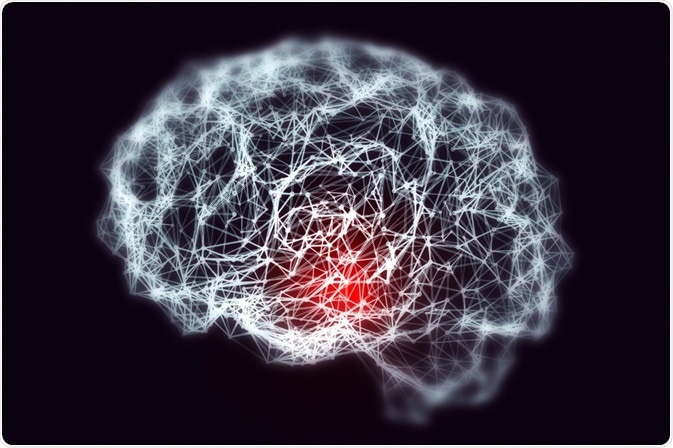 Image Credit:Shutterstock/KaterynaKon
Image Credit:Shutterstock/KaterynaKonNoradrenaline is well-known as a catecholamine neurotransmitter. It is produced by noradrenergic neurons that release it from axonal terminals spread widely over the brain. The majority of noradrenaline in the brain is produced by the locus coeruleus (LC) in the dorsal part of the brain stem, which has neurons projecting throughout the brain. Noradrenaline released from LC projections acts on adrenergic receptors expressed on neurons, microglia, and astrocytes.
The role of noradrenaline as a hormone within the brain, causing potent anti-inflammatory, anti-oxidative, neurotrophic, and neuroprotective actions, is less well known1. Noradrenaline is involved in general arousal, selective attention, memory, and stress reactivity. A deficit of noradrenaline is associated with neurodegeneration and this has been implicated in the aetiology of Alzheimer’s disease2.
Degeneration of the LC, the primary source of noradrenaline in the brain, has been noted early in the pathogenesis of Alzheimer’s disease. Furthermore, the extent of LC neuron loss has been shown to correlate well with the number of amyloid plaques and the severity and progression of dementia3.
There is thus a keen interest to study the role of noradrenergic neurons in the brain and to define their role in the development of Alzheimer’s disease with a goal to develop disease-modifying treatments.
Role of noradrenaline in Alzheimer’s disease
Alzheimer's disease is the most common cause of dementia characterized by progressive cognitive decline. The disease arises as a consequence of excessive deposition of amyloid peptide plaques in the brain4. There is increasing evidence that the pathogenesis of Alzheimer's disease, in addition to the well-known neuronal disturbance, also has cerebral immunological elements that implicate noradrenalin in its aetiology3,5.
Although the LC is known to decrease in size during normal aging, a more pronounced loss has been observed in patients with Alzheimer’s disease and loss of LC neurons increases the risk of developing Alzheimer’s disease6.
The body's response to misfolded and aggregated proteins triggers an innate immune response, which leads to the release of inflammatory mediators. The resultant inflammation worsens disease severity and can accelerate disease progression. The anti-inflammatory action of noradrenalin can temper such inflammatory responses. Indeed, experimentally induced noradrenalin loss has been shown to increase both inflammation and amyloid plaque deposition2,7. Consequently, early degeneration of the LC and the subsequent loss of noradrenalin-mediated innervation may result in a substantially greater inflammatory response to a stimulus, such as amyloid plaques.
Imaging noradrenergic neurons
In vivo molecular imaging of noradrenaline neurons may provide insights into the extent of the degeneration and potentially lead to novel treatment strategies for Alzheimer’s disease.
The cell bodies of noradrenalin neurons are rich in copper ions as these are required for the enzymatic reaction catalyzed by dopamine β-hydroxylase that converts dopamine to noradrenaline. Indeed, the copper concentration in the LC is up to 20-fold higher than in other areas of the brain. This means that noradrenaline neurons contain abundant water protons that have a shortened T1 due to paramagnetic ions.
T1-weighted magnetic resonance imaging (MRI) with magnetization transfer (MT) is being explored as a research tool for studying pathological degeneration of noradrenaline neurons. Combining T1-weighted MRI with magnetization transfer (MT-MRI) does not affect the increase in MRI signal induced by paramagnetic ions but suppresses the signals from water molecules in contact with diamagnetic macromolecules8.
The technique was recently used successfully to delineate noradrenaline neurons in vivo in a mouse transgenic model of Alzheimer’s disease9. High-field MRI measurements of the brain stem were carried out at 9.4 T using Bruker BioSpec® instrumentation that combines MRI CryoProbe™ technology with ultra-high field USR magnets to deliver a high spatial resolution. Anatomical cross-sections were obtained from the original 3D MRI data sets by multiplanar reconstructions using Bruker Paravision 5.0 software.
The locus coeruleus, dorsal motor vagus nucleus, and nucleus tractus solitarius were all clearly identified, and a significant correlation was observed between MT MRI signal intensity and proton density. Preservation of the high MRI signal in mice unable to produce dopamine β-hydroxylase confirmed that the signal was not due to neuromelanin, dopamine β-hydroxylase or its binding to paramagnetic ions.
The absence of a high MRI signal from the locus coeruleus of transgenic mice lacking noradrenergic neurons confirmed that cell bodies of noradrenergic neurons were the source of the bright MRI appearance. Proton magnetic resonance spectroscopy revealed that the 60–75% reduction in noradrenalin led to a reduction of N-acetylaspartate and glutamate in the hippocampus as well as a shortening of the water proton T2 in the frontal cortex.
This is the first time that noradrenergic neurons have been imaged in vivo. Data from this ground-breaking research support the hypothesis that a concurrent shortage of noradrenalin in Alzheimer’s disease accelerates pathologic processes such as inflammation and neuron loss.
References
- O'Donnell J, et al. Neurochem Res. 2012; 37(11):2496‑512.
- Kummer MP, et al. J Neurosci. 2014 Jun 25;34(26):8845‑8854. https://www.ncbi.nlm.nih.gov/pmc/articles/PMC4147626/
- Heneka MT, et al. Lancet Neurol 2015;14:388‑405. https://www.ncbi.nlm.nih.gov/pmc/articles/PMC5909703/
- Langa KM, Burke JF. AMA Intern Med. 2019;179(9):1161-1162. https://jamanetwork.com/journals/jamainternalmedicine/fullarticle/2737753
- Zhang B et al. Cell 2013;153(3):707‑720.
- Zarow C, et al. Arch Neurol. 2003;60(3):337-41
- Kalinin S, et al. Neurobiol Aging. 2007;28:1206–14. https://www.ncbi.nlm.nih.gov/pubmed/16837104
- Watanabe T, et al. Neuroimage 2012;63:812–817
- Watanabe T, et al. Brain Structure and Function 2019;224:1609–1625. https://link.springer.com/article/10.1007/s00429-019-01858-0